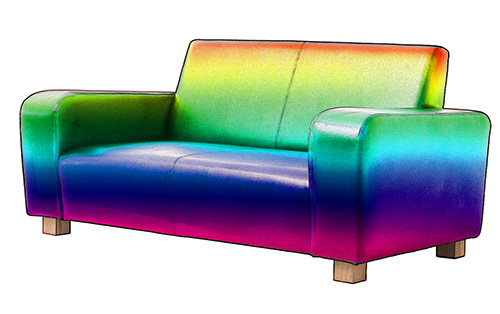November 2013
Good Deeds and Attaboys
12/11/13 22:07 Filed in: Helping out
As consumers we play an important role in the American economic ecosystem. We determine what is the best value for us and reward the winner with our dollars. But if we really like a company we can go beyond and positively impact their success.
The other day I stopped into my favorite Burger King for lunch. It's the one on Stark St in Gresham, by the Home Depot. Why is it my favorite? Don't all Burger Kings have the same menu, the same basic decor, etc? Well, yes, but this place is different. Oh, they have the same menu, but the service is amazing! We were greeted with a "Welcome to Burger King!" when we entered, but more than that, the people who waited on us smiled and were friendly! Our meals were hot and fresh from the grill. It was a wonderful meal.
When we left, I made a point to compliment the servers, asking them to pass on those compliments to the managers. In turn they asked me to fill out their survey on the back of the receipt. I knew that was a way I could really recognize their efforts. So, I plan to do just that.
How do you recognize the efforts of the people and companies you deal with and like especially well? Perhaps you've never given that much thought. In this digital world, feedback can really assist your favorite companies to flourish.
When you spread the good word about a place onLine, the search engines notice. They all rank websites by "Authority" and that comes from mentions, #hashtags, back links, reviews, and myriad other sources that are considered when deciding on which page the website shows up in a web search. When they land on the front page, others can discover them, too. And more customers means a stronger more stable organization. That’s good for the company, but also for the client because our favorite place will be more likely to be around when we need them.
Let's take a look at a few ways you can contribute to that stream of data:
Reviews:
Yelp , Google Places, and Angie's List are just 3 of the dozens of great places to put in a good word. Tell people what you like and dislike about the place and give it a rating. The more ratings a place gets the more attention it garners!
twitter:
Even if you only have a few followers on twitter, you can reach a lot of people by using the # sign to create a "Hashtag". By using the # symbol along with a word or phrase that others might search for, your tweet can be seen by many folks you don't know. For example the above experience might carry a hashtag of #great_burger or #Burger_King.
Facebook:
Like their company pages. Share their posts with your Facebook friends.
Blogs:
If you write a blog, mention the company's website and provide a link. These are called inbound links and are incredibly helpful to a site's ranking.
Website:
If you have your own website, consider "trading links" with your favorite suppliers. If you mention them, they often will return the favor, thus helping to build your presence and authority as well.
Newsletters/email "blasts":
If you have a newsletter or send out some other regular eMail, tell your subscribers about your favorite suppliers!
Word Of Mouth:
Tell your friends! The oldest and best way to help your friends in business!
The other day I stopped into my favorite Burger King for lunch. It's the one on Stark St in Gresham, by the Home Depot. Why is it my favorite? Don't all Burger Kings have the same menu, the same basic decor, etc? Well, yes, but this place is different. Oh, they have the same menu, but the service is amazing! We were greeted with a "Welcome to Burger King!" when we entered, but more than that, the people who waited on us smiled and were friendly! Our meals were hot and fresh from the grill. It was a wonderful meal.
When we left, I made a point to compliment the servers, asking them to pass on those compliments to the managers. In turn they asked me to fill out their survey on the back of the receipt. I knew that was a way I could really recognize their efforts. So, I plan to do just that.
How do you recognize the efforts of the people and companies you deal with and like especially well? Perhaps you've never given that much thought. In this digital world, feedback can really assist your favorite companies to flourish.
When you spread the good word about a place onLine, the search engines notice. They all rank websites by "Authority" and that comes from mentions, #hashtags, back links, reviews, and myriad other sources that are considered when deciding on which page the website shows up in a web search. When they land on the front page, others can discover them, too. And more customers means a stronger more stable organization. That’s good for the company, but also for the client because our favorite place will be more likely to be around when we need them.
Let's take a look at a few ways you can contribute to that stream of data:
Reviews:
Yelp , Google Places, and Angie's List are just 3 of the dozens of great places to put in a good word. Tell people what you like and dislike about the place and give it a rating. The more ratings a place gets the more attention it garners!
twitter:
Even if you only have a few followers on twitter, you can reach a lot of people by using the # sign to create a "Hashtag". By using the # symbol along with a word or phrase that others might search for, your tweet can be seen by many folks you don't know. For example the above experience might carry a hashtag of #great_burger or #Burger_King.
Facebook:
Like their company pages. Share their posts with your Facebook friends.
Blogs:
If you write a blog, mention the company's website and provide a link. These are called inbound links and are incredibly helpful to a site's ranking.
Website:
If you have your own website, consider "trading links" with your favorite suppliers. If you mention them, they often will return the favor, thus helping to build your presence and authority as well.
Newsletters/email "blasts":
If you have a newsletter or send out some other regular eMail, tell your subscribers about your favorite suppliers!
Word Of Mouth:
Tell your friends! The oldest and best way to help your friends in business!
Art vs Decor?|The Perceived Value Dilemma
03/11/13 20:11 Filed in: Marketing

“It isn’t art if it matches your couch!”
“It’s much better in Europe. They have a tradition of buying art!”
“I kicked someone out of my studio once because they brought a fabric swatch in to match to!”
We’ve been having a discussion around the office with our clients, and these were just a few of the similar statements made. In fact one was on a t-shirt!
It centered around…
“Why is it so hard to sell artwork?”
I took an informal poll… nothing scientific about it, I just asked friends.
The question was, “What are you more likely to spend $500 on, a piece of art or something to decorate your home?”
First, we guys didn’t fair well. For the most part we just stared in disbelief, deferred to our “better half , or professed a preference for a 60” TV.
Amazingly, very few people viewed art as decoration. Somehow art has become a different class of possession … one that is considered a super luxury. While that may allow us to command higher prices for our work, it also suppresses demand to the point that few talented artists actually make a living selling their art.
Just as you can charge anything you like for something you don’t have (lack of supply), you can also charge what you like for something that no one is buying (lack of demand). The general public’s perception seems to be that art is superfluous for all but the wealthy… even though those same people will spend thousands of dollars on “Home Decor.”
The Home Decor market is orders of magnitude larger than the fine art market, yet the potential customer is the same and the amount of money charged is similar! Price is not the issue, perception of value is.
“The fault, dear Brutus, is not in our stars, but in ourselves…”
As long as we relish the difference between fine art and decor, we will be separated from that market and more importantly, the general public will continue to value the money in their pocket more than the artworks we produce. In essence, this is why “starving artist” is a cliché. It’s all about perceived value. At present, the average Joe would much rather spend $500 on the new TV, his wife might opt for a piece of furniture or a framed print from IKEA (or maybe it’s the other way around) but it is highly likely that both would vote to keep their money in their bank account instead of buying that wonderful piece of art.
This isn’t something we can solve as a group, changing perceived value is something we must work on as individuals and constantly. Perhaps we should start by finding out what color our potential client’s couch is.
